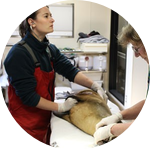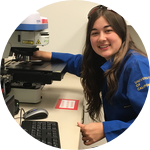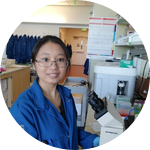About This Project
Marine mammals, like dolphins, eat food contaminated by microplastic pollution, which could cause serious health effects. This project will evaluate samples from marine mammals stranded on beaches to determine whether microplastics or additives are present in their tissues. We will evaluate which species are exposed to plastic pollution and where it is found in the body. This project is a critical step for understanding risks of microplastics to marine mammals.
Ask the Scientists
Join The DiscussionWhat is the context of this research?
As plastic use increases, contamination of environments with pieces of plastic (microplastics) is more common. Pieces from products like microbeads in cosmetics, lint from synthetic clothing, and breakdown of larger items like bottles make their way to the oceans, where they are eaten by animals like whales and sea lions. While plastics may seem harmless due to their widespread use, we are just beginning to understand the effects they have on animals and ecosystems. They can cause physical damage, can lodge in organs, transport other harmful pollutants or germs (like a sponge), or release toxic compounds. Identifying which animals are exposed and which organs microplastics or their additives are found in is needed to understand how they can impact marine mammals.
What is the significance of this project?
Earth has seen a dramatic decrease in wildlife populations over the last 50 years and is currently in the midst of its 6th mass extinction, thought to be primarily caused by human activity. This project tackles one of the world's rapidly emerging concerns facing wildlife - the introduction of plastic pollution into the environment. Results will provide much-needed comparative data on which species of marine mammals are affected and in what tissues microplastics and their additives are found. Very little work has been done to determine the health risks posed by microplastics to marine mammals, and the data from this project will be used to inform design of a larger prospective research program for effective use of available samples and resources.
What are the goals of the project?
This project is a pilot study, which means its data will be used as preliminary information crucial for planning a larger and more robust study. With this project, we plan to use banked frozen samples collected at the Marine Mammal Center during strandings to:
1. Evaluate marine mammal tissues and fecal material from stranded animals for evidence of exposure or the presence of microplastic particles and additives.
2. Compare results from the different tissues and species to determine which samples are best to target in a larger planned study.
To achieve success, we would need to analyze 3 samples (2 tissues and 1 feces sample for microplastics and additives) from each of three individual animals of 3 different species, for a total of 27 samples.
Budget
To get started, we need at least $4958. With additional funding we can complete analysis for more samples, animals, and species to build on our initial data!
$183 = one sample
$551 = one animal (3 samples)
$1652 = one species (3 animals)
$4958 = three species (our minimum goal!)
BUDGET ITEMS
Sample shipping: To get frozen samples from stranding sites to our lab
Lab supplies/sample preparation: Includes specific chemicals and equipment needed to digest and process the samples so we can separate out microplastic particles or additives and properly analyze them (like centrifuge tubes, digestion/extraction chemicals, glass separation funnels, and filters).
Sample analysis: Calibration of Raman microscope (very important for really small particles!!), reagents needed for gas chromatography, and data analysis software.
Endorsed by
 Project Timeline
Project Timeline
Samples will be chosen based on the availability of both tissue and fecal material from single individuals across multiple species.
In order for us to be able to scale up the project in the future, we will need to demonstrate a correlation between microplastics found in feces and leached plastic additives found in tissue samples.
Timeline may be altered for safety during the current coronavirus pandemic.
Aug 31, 2020
Project Launched
Nov 01, 2020
Milestone 1: Samples are shipped from stranding sites to our lab
Dec 01, 2020
Milestone 2: Fecal samples digested and particles isolated for analysis
Feb 01, 2021
Milestone 3: Raman analysis for microplastics completed for fecal samples
Mar 01, 2021
Milestone 4: Tissue samples processed and extracted for analysis
Meet the Team
Affiliates
Affiliates
Affiliates
Affiliates
Affiliates
Team Bio
The UC Davis HEAL (Health Effects of Anthropogenic Litter) Lab is led by Dr Jenessa Gjeltema. We operate within the UC Davis One Health Institute, where we work at the interface of animals, people, and the environment to solve complex problems impacting health and conservation.
Jenessa L Gjeltema, DVM, Dipl. ACZM
I have always been intrigued by the complex relationships between humans, animals, and our shared environment.
As an undergraduate at the College of Charleston in South Carolina, I dove head-first into these interests and triple-majored with honors in International Business, Business Administration, and Philosophy focusing on topics including animal ethics, business operations, and resource economics.
Upon graduation, I decided to pursue a career as a zoological/wildlife veterinarian so that I could put my passion for conservation into practice. After completing all pre-requisite requirements, I was accepted into veterinary school at North Carolina State University College of Veterinary Medicine.
After completion of veterinary school with honors, I went on to complete a 1-year internship in small animal medicine and was then accepted into a 3-year post-doctoral Zoological Medicine residency training program through North Carolina State University and the North Carolina Zoo. During my veterinary and residency training, I completed research projects in diverse topics including ecotoxicology and even tarantula anesthesia (!).
Upon completion of my residency training, I was invited to UC Davis School of Veterinary Medicine to help with teaching veterinary students and providing medical care for the Sacramento Zoo's animals. Shortly after, I was appointed into my role as assistant professor of Zoological Medicine and also became a Board-certified Veterinary Specialist in Zoological Medicine.
My primary personal research interest is in understanding the health effects of microplastic pollution. Through the HEAL (Health Effects of Anthropogenic Litter) Lab, our team conducts a variety of projects that include development of validated methodologies, performance of environmental monitoring, and evaluating effects on wild animal populations and their ecosystems.
Jackie Lang
I have always been fascinated by pollution in aquatic ecosystems because I grew up along the Ohio River, one of the most polluted rivers in North America. I spent my summers collecting trash along streams, catching fish (but not eating any), and wishing I could swim in the river without occasionally developing a rash.
I received my B.S. in environmental toxicology from UC Davis, where I learned from world-leaders in topics like pesticide residues in table crops and the toxicity of hydrocarbons after large oil spills. This inspired me to complete a summer research project at the UC Davis Bodega Marine Laboratory on the toxic effects of oil dispersants to hydrocarbon-degrading microbial communities.
After graduating, I returned to the Ohio River where I completed an internship in aquaculture and biological monitoring before accepting a position as an aquatic ecotoxicologist at an environmental consulting firm. I gained extensive experience in marine and freshwater aquatic toxicity testing and sediment toxicity testing.
Since 2018, I have been employed as a Research Associate in Dr. Jenessa Gjeltema's HEAL (Health Effects of Anthropogenic Litter) lab at UC Davis. I have become an expert on microplastic extraction and analysis using Raman spectroscopy - the gold standard method for chemically identifying the smallest microplastics. Our work on method development for semi-automation of our Raman confocal microscope was presented at the Society of Environmental Toxicology and Chemistry North America annual meeting in 2019. We have a manuscript in progress reviewing scientific literature for everything that is currently known about the presence and health effects of microplastics in marine mammals.
I am very excited to be starting my graduate studies in agricultural and environmental chemistry in Fall 2020. I intend to research the interactions of other pollutants with microplastics as well as the leaching of plastic additives from microplastics into aquatic environments.
Prathima Garudadri
Growing up in sunny San Diego, I spent my weekends at the beach, San Diego Zoo and Seaworld; we were outdoors year-round. This sparked a love of animals and nature from a young age that continues to drive my career and life choices. In my free time I love to travel; through these experiences I have seen the beauty of our planet, the animals who inhabit it and the harmful effects that humans have on the environment.
I received my bachelors in Physiology and Neuroscience with a minor in Cognitive Science from UC San Diego in 2018 with the original intention of going to medical school or working in a neuroscience lab. While getting my bachelors degree, I worked as a veterinary assistant at a small animal general practice veterinary hospital, volunteered at a equine therapy facility for veterans with PTSD and developed youth outreach programs with the San Diego Association for Women in Science. These experiences working with animals, people and witnessing the power of the human animal bond led me to pursue a career in veterinary medicine.
I am now a second year student at the UC Davis School of Veterinary Medicine. Our curriculum has reinforced my belief that the animals we work with, the environment and human health are all intertwined. To explore my varied interests, I’ve been working as an assistant doing treatments in the small animal teaching hospital and have taken on officer positions for various clubs associated with wildlife medicine, emergency medicine, disaster response and business. This summer, I was fortunate enough to get a grant to spend working in the Gjeltema HEAL (Health Effects of Anthropogenic Litter) lab writing a scoping literature review on the health effects of microplastics in marine mammals which has been an eye opening experience. This work has united many of my passions and I am excited to continue working on this project alongside my graduate studies.
Swee Teh
I am the director of Aquatic Health Program (AHP)
in the Department of Anatomy, Physiology, and Cell Biology in the School of Veterinary Medicine at the University of California-Davis. AHP mission is to promote and protect the well-being of all aquatic species and their environments by investigating the anatomical, behavioral, molecular, and physiological components of individual organisms and applying them to the ecosystem scale. I have been researching aquatic health, including the effects and interactions of physicochemical and contaminant stressors (toxicant, carcinogen, and endocrine disruptor) on aquatic organisms and ecosystems for >30 years. My research agenda is summarized in two main categories: 1) Development of the aquatic health screening and testing program, and 2) Development of the aquatic organism health monitoring program. I am also the director of the Aquatic Toxicology Laboratory; a State Certified Laboratory engaged in monitoring and assessing ambient water quality and aquatic ecosystem health, therefore is dedicated to producing high quality reliable data which are ensured through a variety of protocols and criteria established by the US EPA.
Erin Berlin
My interest in how environmental health can impact both human and animal health began when I studied Environmental Science for my B.S. at UCLA. I was able to part of several research projects, including a Field Research Quarter centered on animal behavior and conservation behavior, that helped me focus my interests on conservation medicine. After graduating from UCLA, I worked at a small animal veterinary clinic before starting veterinary school at Western University of Health Sciences. Throughout school, I was lucky to have externship and internship experiences at many zoological institutions, including the Smithsonian Conservation Biology Institute, the Houston Zoo and San Diego Zoo, and participate in research projects for various species, spanning from gorillas to toads. After school, I completed a small animal rotating internship at a large private practice veterinary clinic in California, followed by a specialty internship and associate position at the Henry Doorly Omaha Zoo and Aquarium. This year, I am lucky to be the first year zoological medicine resident through UC Davis School of Veterinary Medicine and San Diego Zoo Global. I am so grateful for the opportunity to work on this project, and that I am able to combine my strong interest in marine mammal medicine with my passion for environmental health.
Cara Field
.
Chelsea Lam
I am currently entering my third year of graduate school in the Pharmacology & Toxicology program at UC Davis. My research looks at the impact of contaminants on phytoplankton and cyanobacteria in the San Francisco Estuary. As a part of the UC Davis Aquatic Health Program and a Delta Science Fellow, one of my goals is to contribute to the scientific knowledge on contaminants in California’s Bay-Delta system so that we can better manage our water resources for the future.
I’ve always wanted to combine my love for biology and chemistry, while also working on solving problems that impact human and environmental health. As an undergraduate at UC Davis, I first worked in an air quality research lab doing FTIR spectroscopy of particulate matter. I loved working with the instrument, and also getting to see the other equipment in the lab that analyzed chemical composition of what people were breathing from places all around the US. I also started to volunteer for a drought study looking at blooms of toxin-producing cyanobacteria in the San Francisco Estuary being run by the Aquatic Health Program and the Department of Water Resources. This led to my fascination with algae and their role in ecosystem health as climate changes and waterways become increasingly impacted by human activities. I graduated from UC Davis in 2016 with a B.S. in environmental toxicology with an emphasis in aquatic toxicology and environmental chemistry.
When I returned to graduate school at UC Davis, I was excited to continue helping with projects dealing with the health impacts of contaminants in aquatic ecosystems. As always, I also enjoyed lab work with a variety of equipment and procedures. I further developed my analytical chemistry skills in GC and LC systems, as well as got to return to FTIR spectroscopy doing analysis of plastic in recycled carpet material at UC Berkeley’s Advanced Light Source. I am grateful to be able to continue working on projects in environmental health.
Additional Information
The coronavirus pandemic has impacted us all in many ways - for our lab, it has impacted our ability to conduct research. The ongoing coronavirus crisis has not ceased the importance of addressing other urgent crises, such as climate change and the ongoing contamination/destruction of our environment. In many ways, it has allowed us to pause and reflect upon what is important. Despite the new challenges of continuing research activities during this new era, we think it is important to move forward. While we don't know what the future will hold, we will continue to do our part in creating a world which is safer, healthier, and more sustainable.
Project Backers
- 54Backers
- 115%Funded
- $5,715Total Donations
- $105.83Average Donation







